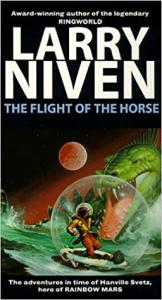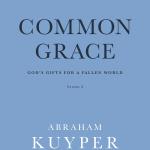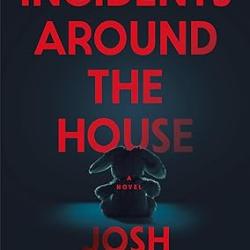
Larry Niven is one of the great writers of Science Fiction. His Ringworld is a genre-defining text that absolutely every sci-fi fan should read. And yet even great writers occasional churn out merely adequate works. Niven’s collection The Flight of the Horse is one such work. Gathering together Niven’s short stories with tinges of fantasy (and one out-and-out fantasy story) along with his novella Flash Crowd, this short book is a quick read and one that will scratch your sci-fi itch, if you have such a thing.
Without giving away any spoilers, the pure fantasy story in the mix (“What Good is a Glass Dagger?”) wonders what happens if the source of magic (“mana”, no doubt drawn from the D&D world) turns out to be finite and is in danger of getting used up? The implication is (and this isn’t a spoiler for the plot) that people will have to turn to technology when it comes to killing each other. The mixed sci-fi/fantasy stories involve a series of narratives loosely organized around Svetz’s trips into the past to gather extinct creatures for the pleasure of the world’s mad tyrant. These trips end up being more trouble than they’re worth. For example, the horse Svetz collects keeps trying to stab him with its horn, the Gila Monster keeps trying to roast him alive, and the black and white roc can’t fly and just stands around on its long legs staring from atop its long neck.
Again, this collection is fine. But it probably wouldn’t merit inclusion here (I read lots of these throwaway sci-fi collections), if it weren’t for a bit in the middle of the one pure sci-fi story in the mix. Flash Crowd introduces Niven’s idea of instantaneous travel by means of “Displacement Booths” that conduct an individual from one point on the planet to another. Flash Crowd explores the question of what that means for things like airline travel, crime (can you ever really stop smuggling with those things around?), waste disposal (just displace it into space!), and tourism. But the interesting bit comes when the lead characters discuss its effects on the relationship between media, instant communication, and public response. Two characters point out the dangerous effects of people being able to, say, instantly join in a riot anywhere in the world. What should the media do?
“Maybe put some restrictions on newstaping practices. We’re too fast these days. A machine won’t work without friction. Neither does a civilization… But we’d ruin the networks, wouldn’t we?
Take away the news broadcasts, and they wouldn’t have anything left to sell but educational TV. Nothing to sell but toys and breakfast cereal.” (120-121)
This is remarkably prescient. What would be better for us as a society than a bit of a breather between when events happen and when we find out about it? Isn’t that bit of time to calm down and reflect critical? Maybe all Tweets should have a 24 hour delay built in. But then, who would use Twitter? If nothing of substance were allowed, wouldn’t it be just all spam and meaningless nothings? (More so than it is already, anyway.)
Again, I don’t know that the predictions Niven makes here are worth taking the time to read this (particular if you’ve not read Ringworld), but it is a serviceable enough collection, and it certainly won’t do you any harm. Certainly as Christians the idea that we should slow down and think carefully before jumping into what’s going on in the culture is a virtue we’d do well to cultivate.
Dr. Coyle Neal is co-host of the City of Man Podcast an Amazon Associate (which is linked in this blog), and an Associate Professor of Political Science at Southwest Baptist University in Bolivar, MO












